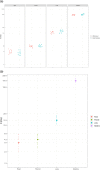Development of a quasi-humanoid phantom to perform dosimetric and radiobiological measurements for out-of-field doses from external beam radiation therapy
- PMID: 35104047
- PMCID: PMC8992956
- DOI: 10.1002/acm2.13514
Development of a quasi-humanoid phantom to perform dosimetric and radiobiological measurements for out-of-field doses from external beam radiation therapy
Abstract
Our understanding of low dose, out-of-field radiation and their radiobiological effects are limited, in part due to the rapid technological advances in external beam radiotherapy, especially for non-coplanar and dynamic techniques. Reliable comparisons of out-of-field doses produced by advanced radiotherapy techniques are difficult due to the limitations of commercially available phantoms. There is a clear need for a functional phantom to accurately measure the dosimetric and radiobiological characteristics of out-of-field doses, which would in turn allow clinicians and medical physicists to optimize treatment parameters. We designed, manufactured, and tested the performance of a quasi-humanoid (Q-H) adult phantom. To test the physics parameters, we used computed tomography (CT) scans of assembled Q-H phantom. Static open field and dynamic techniques were measured both in- and out-of-field with ionization chambers and radiochromic films for two configurations (full solid and with water-filled containers). In the areas simulating soft tissues, lung, and bones, median Hounsfield units and densities were, respectively: 129.8, -738.7, 920.8 HU and 1.110, 0.215, 1.669 g/cm3 . Comparison of the measured to treatment planning systems (TPS) in-field dose values for the sample volumetric arc therapy (VMAT) (6 MV flattening filter-free (FFF)) plan, 96.4% of analyzed points passed the gamma evaluation criteria (L2%/2 mm, threshold (TH) 10%) and less than 1.50% for point dose verification. In the two phantom configurations: full poly(methyl) methacrylate (PMMA) and with water container, the off-axis median doses for open field, relative to the central axis of the beam (CAX) were similar, respectively: 0.900% versus 0.907% (15 cm distance to CAX); 0.096% versus 0.120% (35 cm); 0.018% versus 0.018% (52 cm); 0.009% versus 0.008% (74 cm). For VMAT 6 MV FFF, doses relative the CAX were, respectively: 0.667% (15 cm), 0.062% (35 cm), 0.019% (52 cm), 0.016% (74 cm). The Q-H phantom meets the International Commission on Radiation Units and Measurements (ICRU) and American Association of Physicists in Medicine (AAPM) recommended phantom criteria, providing medical physicists with a reliable, comprehensive system to perform dose calculation and measurements and to assess the impact on radiobiological response and on the risk of secondary tumor induction.
Keywords: humanoid phantoms; out-of-field doses; radiobiological response; risk modeling.
© 2022 The Authors. Journal of Applied Clinical Medical Physics published by Wiley Periodicals, LLC on behalf of The American Association of Physicists in Medicine.
Conflict of interest statement
The authors declare no conflict of interest.
Figures






References
-
- Kruszyna M, Adamczyk S, Skrobała A, et al. Low dose out‐of‐field radiotherapy, part 1: measurement of scattered doses. Cancer/Radiothérapie. 2017;21(5):345‐351. - PubMed
-
- Skrobala A, Adamczyk S, Kruszyna‐Mochalska M, et al. Low dose out‐of‐field radiotherapy, part 2: calculating the mean photon energy values for the out‐of‐field photon energy spectrum from scattered radiation using Monte Carlo methods. Cancer/Radiothérapie. 2017;21(5):352‐357. - PubMed
-
- Zaleska K, Suchorska WM, Kowalik A, et al. Low dose out‐of‐field radiotherapy, part 3: qualitative and quantitative impact of scattered out‐of‐field radiation on MDA‐MB‐231 cell lines. Cancer/Radiothérapie. 2017;21(5):358‐364. - PubMed
MeSH terms
Substances
Grants and funding
LinkOut - more resources
Full Text Sources

